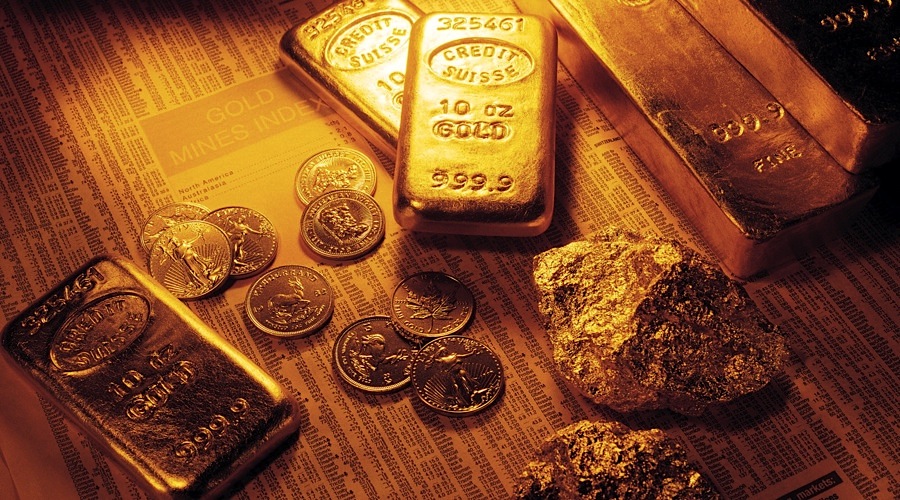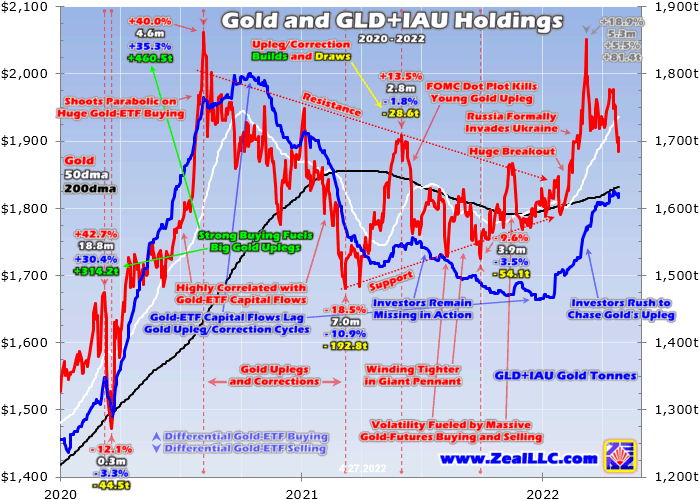Gold investment surging

Gold investment demand is surging as traders increasingly comprehend this leading alternative asset’s amazing fundamental backdrop. The biggest inflation super-spike since the 1970s is relentlessly eroding purchasing power, while the bubble-valued US stock markets are rolling over into a long-overdue bear. So investors are flocking back to gold, driving its price higher enticing in more traders to chase those gains.
Gold’s current secular bull was born way back in mid-December 2015, when the Federal Reserve kicked off its previous rate-hike cycle. Over the 6.4 years since, gold’s best gains extended to 96.2% at early August 2020’s bull-to-date peak. That’s still quite small, dwarfed by gold’s previous secular bull that soared 638.2% higher between April 2001 to August 2011! Strong investment demand fuels these big bull runs.
But global investment capital inflows into gold are opaque, challenging to track. The best-available data is only published quarterly by the venerable World Gold Council, in its excellent Gold Demand Trends reports. Unfortunately that sparse update frequency leaves that supply-and-demand data insufficient to actively game gold-bull uplegs and corrections. Thankfully there’s a great daily high-resolution proxy for it.
The combined physical-gold-bullion holdings of the leading and dominant American GLD SPDR Gold Shares and IAU iShares Gold Trust gold exchange-traded funds closely mirror world gold investment flows. They are published daily, revealing whether American stock-market capital is flowing into or out of gold. When the yellow metal is moving, GLD+IAU holdings usually dominate quarterly gold investment.
Consider two recent quarters where gold surged and plunged. In Q2’20 it roared 12.9% higher emerging from the pandemic-lockdown stock panic. The WGC’s data revealed worldwide gold investment demand that quarter skyrocketed 98.8% year-over-year or 290.4 metric tons. The huge 276.8t quarterly build in GLD+IAU holdings alone accounted for over 19/20ths of that! These ETFs are gold-market juggernauts.
Later in Q1’21 after massive uplegs, gold plunged 10.0% extending a healthy sentiment-rebalancing correction. The WGC revealed global gold investment demand cratered 66.9% YoY or 372.4t! That quarter GLD+IAU holdings suffered a huge 154.4t draw as American investors fled. A year earlier the comparable Q1’20 had seen a 104.7t build. Added together, that 259.1t GLD+IAU swing made for 7/10ths of the total.
During most quarters GLD+IAU holdings closely track the WGC’s comprehensive global supply-and-demand data. That makes them a fantastic near-real-time window into how gold investment demand is faring. And it has really surged recently, with American stock-market capital pouring back into the yellow metal. This chart superimposes GLD+IAU holdings on gold technical action over the past couple years or so.

This gold bull’s broader uplegs and corrections have proven highly-correlated with the fortunes of these mighty American gold ETFs. Gold powers higher when American stock-market capital is flowing in, then grinds lower when it is pulled back out. Gold ETFs effectively act like conduits for the vast pools of stock-market capital to slosh into and out of physical bullion. That’s necessary to keep their shares tracking gold prices.
Gold-ETF-share supply and demand is independent from gold’s own. That means ETF-share prices will quickly disconnect from gold’s if they experience differential buying or selling relative to gold. The only way to maintain their gold-price mirroring is to shunt excess gold-ETF-share supply or demand directly into the underlying metal itself. Gold-ETF managers equalize capital flows by issuing and redeeming shares.
When GLD shares for example are being bought faster than gold, GLD prices will soon decouple from gold’s to the upside. To avert this, GLD’s managers issue enough new shares to offset any differential demand above gold’s. The resulting cash proceeds from those share sales are then immediately plowed into buying more physical gold bullion. So rising GLD holdings show stock-market capital flowing into gold.
When GLD shares are experiencing differential selling pressure, their prices threaten to break away from gold’s to the downside. So GLD’s managers maintain tracking by buying back enough shares to absorb any excess supply. They raise the cash for these GLD-share repurchases by selling some of this ETF’s gold bullion. Thus declining GLD, GLD+IAU, or any physically-backed gold-ETF holdings reveal capital leaving.
Such a stock-investor exodus from gold-ETF shares plagued the yellow metal last year. Gold investment fell deeper out of favor in 2021, after gold first plunged lower then drifted sideways for a 3.6% loss. With little upside momentum to chase, investors lost interest and dumped enough GLD and IAU shares to slam their holdings 13.5% or 229.2t lower! They hit their nadir of 1,464.6t in late December, a 20.0-month low.
Investment capital flows lag gold uplegs and corrections, as the major trend reversals separating them take some time for investors to recognize and confirm. Gold’s last near-correction-grade selloff actually bottomed at $1,725 a few months earlier in late September. That final capitulation left gold very-oversold and mired deep in widespread bearish sentiment, a perfect breeding ground to spawn a major new upleg.
So gold indeed started marching higher again, despite one of the Fed’s most-extreme hawkish pivots on record! I detailed that relentless drumbeat of unbelievably-hawkish jawboning and actions from top Fed officials in another essay a couple weeks ago. Gold defiantly climbing anyway finally started convincing investors its upleg was sustainable in late January, after its gains had extended to 6.7% over 3.7 months.
After remaining missing in action for months, investment capital inflows into gold suddenly ignited again on January 21st. Massive differential demand for gold-ETF shares blasted GLD+IAU holdings a big 1.9% or 27.6t higher that day! A worsening stock-market selloff likely helped motivate investors to rush back into gold. The flagship S&P 500 stock index had just plunged 5.7% in four trading days on Fed-tightening fears!
Weakening stock markets really boost gold investment demand for prudently diversifying stock-heavy portfolios. Gold tends to rally during material stock-market selloffs, countertrend behavior that makes it an ideal portfolio stabilizer. That investment buying accelerated gold’s upside momentum, attracting in even more investors. They love chasing gains, so investment-driven gold rallies often become self-feeding.
Over the next month or so gold continued to enjoy investment capital inflows as seen in those GLD+IAU holdings. By mid-February they had climbed to 1,516.2t, up 3.5% or 51.6t since their late-December low. By that point gold’s young upleg had powered a solid 8.5% higher over 4.5 months. Up until February 17th, geopolitical fears didn’t affect gold. Traders thought Vladimir Putin’s military buildup was just saber-rattling.
But on February 17th markets started to realize Russia was really preparing to invade Ukraine. Gold shot up 1.7% to $1,899 that day after the US secretary of state warned the United Nations Security Council that Russia was trying to fake a false-flag pretext to justify attacking its small neighbor. GLD and IAU didn’t enjoy much differential buying pressure that day, but it was an inflection point accelerating gold’s upleg.
Including that initial gold surge, in just 13 trading days into early March gold blasted an enormous 9.8% higher to $2,051! That was mostly driven by speculators flooding into hyper-leveraged gold futures, as I analyzed in another essay a couple weeks ago. Yet with gold soaring and uncertainties multiplying with all the implications of Russia actually declaring war, investors jumped on that upside-momentum bandwagon.
During that short gold-geopolitical-spike span, GLD+IAU holdings rocketed up another 3.7% or 55.6t! That was more identifiable investment capital inflows into gold than had previously been seen in its entire young upleg. The gold bullion held by these giant gold ETFs had shot up 7.3% or 106.3t since their late-December low. Since gold’s upleg was born earlier in late September, their holdings had surged 5.5% or 81.4t.
The extreme gold-futures buying that fueled gold’s blistering geopolitical spike was way overextended, so it had to reverse into symmetrical selling hammering gold lower. I warned about that the very day gold peaked in our weekly newsletter, telling subscribers “Unfortunately gold is getting overbought after such a big, fast run.” Thus “the odds for an imminent sharp rebalancing selloff” were soaring, and it soon came to pass.
Over the next week, heavy gold-futures selling slammed gold 6.6% lower to $1,916. Geopolitical spikes are always short-lived, as the headline news that drives them is soon digested then traders move on to other things. But that gold plunge didn’t faze investors, who usually own gold outright and thus face no amplified downside risks. In that span GLD+IAU holdings actually still edged up by a tiny 0.1% or 1.5t.
Gold stabilized from there, indicating speculators had likely already done enough leveraged gold-futures selling to rebalance their overall positioning. Even though gold merely drifted sideways after, in a high consolidation, investors flocked back. Despite gold failing to make any real headway by late March, those GLD+IAU holdings climbed yet another strong 2.3% or 36.1t. Gold investment demand was still surging.
But with gold drifting, upside momentum proved insufficient to attract in new investors. So over the next couple weeks into mid-April, these dominant gold ETFs didn’t see much differential demand. But that quickly picked up again once gold resumed rallying, as investors love chasing upside momentum. As you can see in this chart, gold is now enjoying its biggest investment-demand surge since 2020’s monster one!
At best by late April, GLD+IAU holdings have soared 11.0% or 161.2t since their late-December low! Measured instead from the birth of gold’s upleg in late September, they have marched up an impressive 9.2% or 136.3t. Investors have rushed in to chase gold’s young upleg, greatly accelerating their capital inflows during and after gold’s futures-driven geopolitical spike into early March. This is super-bullish for gold.
Gold’s last major uplegs both cresting in 2020 were fueled by massive investment buying. Gold powered up 42.7% over 18.8 months in the first, largely thanks to American stock investors flooding into GLD and IAU shares so aggressively they forced a huge 30.4% or 314.2t build! In the second upleg out of March 2020’s lockdown stock panic, gold soared 40.0% in just 4.6 months on an epic 35.3% or 460.5t GLD+IAU build!
So today’s young gold upleg up 18.9% at best so far will grow much larger if investors continue moving capital back into gold ETFs. Given gold’s amazingly-bullish fundamental backdrop, it wouldn’t surprise at all to see another 300t-to-450t GLD+IAU build before this upleg matures. That could more than triple the differential gold-ETF-share buying seen so far! These weakening stock markets will continue to contribute.
The flagship US S&P 500 stock index looks to be rolling over into a long-overdue serious bear market. Its latest bull peaked in early January, and this benchmark has already fallen 13.0% at worst as of early March. Interestingly during that several-week gold-geopolitical-spike span into early March, the S&P 500 plunged 6.8% which certainly helped fuel gold’s huge 9.8% surge! Falling stock markets accelerate gold demand.
Exiting 2021 as the S&P 500 hit its latest all-time high, extreme bubble valuations prevailed. These 500 elite American stocks averaged trailing-twelve-month price-to-earnings ratios way up at 33.6x, well above the 28x formal bubble threshold. Such dangerously-high valuations directly fueled by the Fed’s colossal QE4 money printing greatly increase the odds a major bear market is necessary to normalize lofty stock prices.
The deeper the S&P 500’s selloff plumbs, especially after it crosses that 20% new-bear-market threshold, the more gold investment demand will mount. It was Fed-tightening fears that sparked the recent sharp correction, and a new rate-hike cycle is already underway with quantitative-tightening money destruction soon to follow. Both are exceedingly-bearish for lofty stock markets artificially levitated by Fed money printing!
Between March 2020’s pandemic-lockdown stock panic and mid-April 2022, the Fed’s mushroomed its balance sheet by an insane 115.6% or $4,807b! This profligate central bank just effectively more than doubled the US-dollar supply in just 25.5 months! Relatively-way-more money chasing and bidding up the prices on relatively-less goods and services is why inflation is now raging red-hot. This is an epic mess.
High inflation is very bearish for wildly-overvalued stock prices, as it relentlessly erodes corporate profits from multiple fronts. Companies can’t pass along all their soaring input costs to customers, forcing them to eat some of those higher prices. And since everything else is so expensive, consumers simply have less money to buy the goods and services corporations produce. Both revenues and earnings are hit hard!
Lower profits force already-bubble valuations even higher, exerting even more downside pressure on excessively-high stock prices. The weaker stocks get in bear markets, the more investors prudently add counter-moving gold to stabilize their bleeding portfolios. And while inflation and Fed rate hikes are very bearish for stock markets, they are super-bullish for gold. They are going to supercharge its investment demand.
The latest official headline US Consumer Price Index read in March soared 8.5% YoY! That’s its hottest print since all the way back in December 1981, despite this inflation gauge being intentionally lowballed and watered-down for decades. Real inflation is running much hotter, as everyone running households or businesses well knows. Yet even this understated CPI inflation shows its biggest spike since the 1970s.
There were two inflation super-spikes in that decade, and both proved wildly-bullish for gold. I wrote a whole essay comparing gold prices to CPI inflation in mid-January. During that first inflation super-spike in the mid-1970s, gold prices nearly tripled! Then in the larger second one in the late 1970s, gold prices literally more than quadrupled! So they ought to at least double in this first inflation super-spike since then.
Gold was down around $1,800 when radically-excessive Fed easing finally ignited this latest runaway inflation, so it still has enormous upside potential from here. To slay this inflation monster spawned by its own recklessness, this Fed will have to hike its federal-funds rate well above headline inflation rates while also reversing a sizable-to-large fraction of QE4 money printing through QT. Either would crush stock markets.
If this likely-already-underway S&P 500 bear market gets severe enough, the negative wealth effect will spawn a recession or full-blown depression. The Fed won’t want to risk that, so though Fed officials are jawboning aggressively they will drag their feet on actually hiking rates and running QT. Thus this high inflation is likely to fester for years to come. 8.5% inflation can’t be fought with a mere 2.5% federal-funds rate!
Although gold-futures speculators have long been terrified of Fed-rate-hike cycles, they’ve actually proven very-bullish for gold historically. Today’s new one is the thirteenth of the modern monetary era since 1971. During the exact spans of the previous twelve, gold averaged great 29.2% gains. During the eight through which it rallied, gold’s average gains soared to a huge 49.0%! In the other four its losses averaged just 10.5%.
The main reason gold thrives in rate-hike cycles is because they are so darned bearish for stocks. Gold fares best when it enters them relatively-low and they are gradual, the Fed hiking only at its regularly-scheduled FOMC meetings. In mid-March as this thirteenth cycle was born, gold remained 7.1% under its $2,062 bull-to-date peak from early August 2020 fully 19.3 months earlier. That ought to be relatively-low.
And though top Fed officials have been talking tough, they have a long history of quickly capitulating once their tightenings hammer stock markets enough to generate withering criticism from lawmakers. Once the S&P 500 challenged a 20% bear in December 2018, the Fed was quick to cave and prematurely end both its last rate-hike cycle and only other quantitative-tightening attempt. That feebleness should prevail again.
The longer the Fed keeps its federal-funds rate well below the headline CPI inflation, and the slower it moves to unwind its many trillions of QE4 money printing, the longer gold’s fundamentals will remain dazzlingly-bullish. Investors will increasingly realize that as gold continues powering higher on balance on festering inflation and weakening stock markets. This trend should persist for years given this backdrop.
The biggest beneficiaries of higher gold prices are the gold miners’ stocks. As their earnings amplify gold prices, they are enjoying their own mounting upleg. The leading GDX gold-stock ETF has surged 41.4% since late September, paralleling gold’s 14.6% upleg gain! That is making for 2.8x upside leverage, on the high side of the usual 2x-to-3x range. And GDX is dominated by major gold miners, which underperform.
Fundamentally-superior mid-tier and junior gold miners achieve much-better gains during gold uplegs than the majors! They are better able to consistently grow their gold production from smaller bases, while their lower-market-capitalization stocks are easier to bid higher. Our specialty at Zeal is researching this universe to uncover the best gold stocks and silver stocks to trade to multiply wealth during secular gold bulls.
The bottom line is gold investment is surging. Investors started returning to the yellow metal as its young upleg gathered steam, and greatly accelerated their buying during gold’s sharp Russia-invading-Ukraine geopolitical spike. Gold investment capital inflows continued even as that symmetrically collapsed on big gold-futures selling. Then they really ramped back up as investors resumed chasing gold’s upside momentum.
Strong gold investment demand ought to persist on balance for years given this fundamental backdrop. Extreme Fed money printing has fueled the biggest inflation super-spike since the 1970s. The Fed trying to fight that is forcing these QE-levitated bubble-valued stock markets into a new bear. Raging inflation and weaker stock prices supercharge gold investment demand to prudently diversify stock-heavy portfolios.
(By Adam Hamilton)
{{ commodity.name }}
{{ post.title }}
{{ post.date }}

2 Comments
carl johnson
Appreciate this insightful blog! Gold investment is surging due to inflation and falling stock markets. ETFs like GLD and IAU show strong investment demand. With inflation and Fed policies impacting stocks, gold is set for continued growth. Exciting times for gold investors!
corey cochran
Great read! I really love how the article breaks down the various ways to invest in gold. Personally, I’m a big fan of physical gold – I enjoy collecting it as both an investment and a hobby. If anyone else shares that interest and knows where to find the best deals, feel free to share! Always on the lookout for great options.